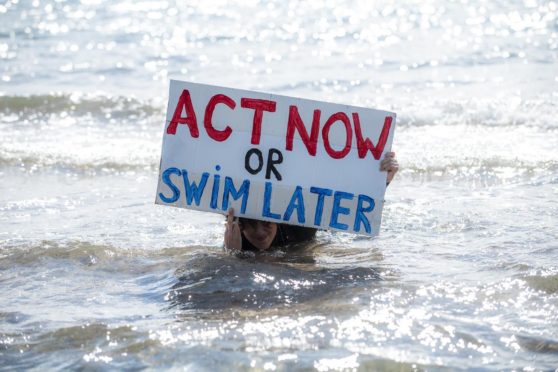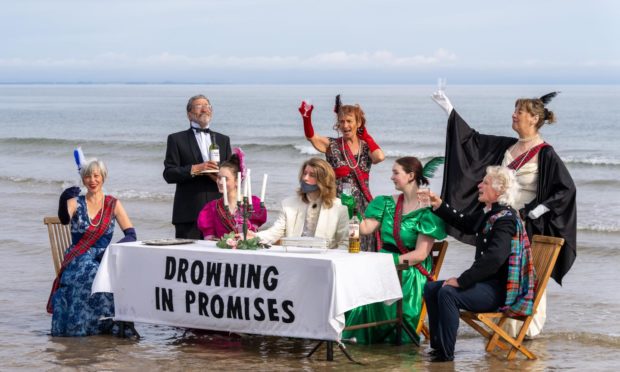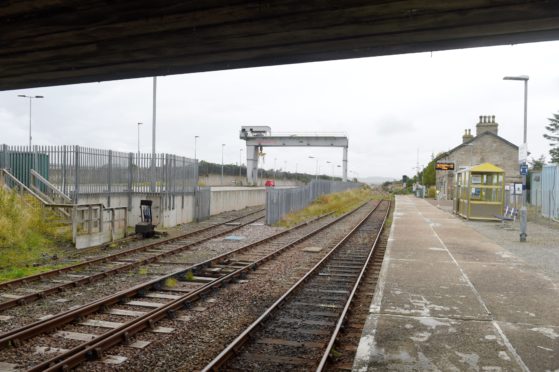The Highlands and Islands Green Party has claimed recent climate change stories have highlighted the “anti-green” spending agendas of the local and national governments.
The regional branch of the Scottish Greens has criticising spending decisions, saying public finance continues to be predominantly allocated to road building schemes.
They argue sustainable solutions “posing little or no climatic impact” are desperately needed right now to prevent climate change.
But Trish Robertson, Highland Council’s climate change working group chairwoman, says the local authority is becoming ever-more energy efficient , however the technology required to go further faster is not yet in place.
It follows four days of action around the UK coast by climate activist group Extinction Rebellion.
Performance pieces on beaches including Findhorn served to raise awareness of climate change-related sea-level rise.
Highland Greens spokeswoman and issues coordinator Anne Thomas said: “Sea-level rise would be catastrophic for Scotland, not only for low-lying coastal areas but would also cause tidal flows to advance much further up river.
“Flooding of the Ness Islands could become a twice-daily event and the recent flood defences are unlikely to be sufficient to protect coastal parts of Inverness.”
She adds: “To prevent climate change, we need sustainable solutions that have little or no climatic impact, and – at the same time – will be embraced by one and all.
“Sadly, the evidence we see from national and local government is not promising.
“For example, some £172million of the Inverness and city region’s total budget of £315 million has been allocated to four road schemes around the city.
“They include the notorious £40million/4km Eastlink.
“That’s £1million for every 100 metres of road. No money at all has been allocated for rail and for active travel, which only comes as part of road projects.”
‘Fallacious’
However, Ms Robertson dismissed the claims and said: “We have active travel associated with road schemes, but we also have active travel associated with schools to help the schools get safer routes to school.
“And we also have it for safer routes for people during Covid. That’s nothing to do with roads.”
She insisted active travel is also associated with the Spaces for People scheme.
The temporary infrastructure programme, funded by the Scottish government, offers funding and support to councils to make it safer for people to walk or cycle for essential trips and exercise during Covid.
“I think the council have been particularly active in getting this going. Everything that we plan now has an active travel route in it,” Ms Robertson said
‘We can’t jump right in’
She added: “We would love to get going with the decarbonisation for the heavy freight but we are not quite there yet as far as the technology is there.
“It is very frustrating not to be able to jump in with both feet and get everything done at once.
“But then again we are restricted with the monies that we have available – and in the meantime, we have to deal with the day-to-day problems – which the West Link will solve some of.”
She said she hoped the local authority would be able to get hydrogen-fuelled bin lorries in the future, after the trials re completed and funding is available.
“As soon as we can get it we will be looking for it,” she added.
‘Rail freight hopes dashed’
It comes as campaigners admit to losing hope over freight trains plan for Far North line.
Community and business leaders have questioned if plans to move more freight by rail in the far north is “commercially viable”.
A £3.1million railhead near Halkirk was built with the aim of securing regular freight movements between Caithness and Inverness.
However, Trudy Morris, chief executive of Caithness Chamber of Commerce, says no commercial operator has been attracted to use the railhead since it was opened in 2012.


